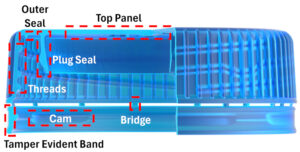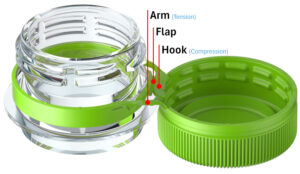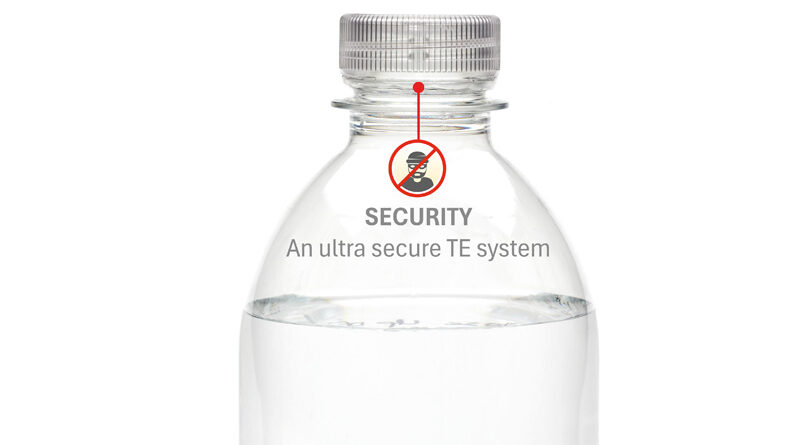PET closures come into their own
Husky’s advances in design, manufacturing and sustainability of caps & closures
Based on an article by Michael White, Director of Business Development, Beverage Closures
Beverage closures are integral to the sustainability of beverage packaging, influencing material usage, recyclability, and consumer experience. Husky Technologies, known for its injection moulding systems and services, has focused on enhancing sustainability in closures through three primary strategies: material light-weighting, tethered closures, and the development of PET closures.
Photo top: Husky’s PET closure solution
Material light-weighting
The light-weighting topic is straight-forward: remove as much resin from specific closure features without negatively impacting the closure performance or the resulting user experience. A lower part weight lowers the raw material cost per piece and can enhance manufacturing productivity (lower cycle time).

Husky makes extensive use of mechanical and melt flow simulation tools, known as finite element analysis (FEA), to develop its closure portfolio. The process begins by breaking the closure down into its specific elements (see Figure 1). The following step focuses on material removal from a specific feature. This light-weighting can include weight removal solely or weight removal and geometry changes. New feature proposals are then rigorously tested through running simulations to predict the performance outcome. This is an iterative approach. This methodology is applied to all closure features until the performance and flow criteria are satisfied. Husky applies this methodology to all its closure designs, achieving key benefits such as faster time-to-market, optimal balance between weight and performance, and reduced development costs.
Simulation tools predict how much material can be removed from each feature without negatively impacting performance and usability.
Tethered closures
Husky has developed an intuitive tethering system. This solution is available for all industry standard (Cetie/ISBT) neck finish types in the water, CSD, and JSDT beverage segments. To ensure a positive consumer experience, tactile and audible responses (“click”) are incorporated into the design to provide immediate consumer feedback on when the shell is locked into position.

Moulding complex tethering geometry is possible with the moulded in bridge approach. The tethered features (arm, flap, and hook) are created using mould slides that form the tethering system (see Figure 2). The slides maximise design freedom and avoid any post mould operations (scoring) of the tamper evident (TE) band and tethering system. This is claimed to simplify the manufacturing approach. Husky’s tethered closure designs, both standard and custom, are engineered to maintain weight neutrality compared to their non-tethered counterparts. These designs also incorporate a shell-locking mechanism to ensure secure functionality and provide an intuitive user experience, making them practical and easy to operate.
A patented tethering system that enables shell locking to improve usability. This technology is available for all neck finish options.
PET closure
Currently, the typical beverage container features a 2-material approach: PET for the bottle and HDPE/PP for the closure. While HDPE/PP performs exceptionally well in terms of protecting/preserving the contents of the beverage, these material types are typically downcycled into other non-food contact applications (lawn furniture, buckets, etc…).
Replacing the closure material with PET, creates a mono-material beverage packaging solution that can increase rPET bale yields, simplify reclamation efforts, and enhance shelf presence with its glass-like properties.
Injection moulding of a PET closure has been an elusive undertaking until now. The material properties are very different than HDPE/PP thereby presenting a unique set of challenges. Leveraging all capabilities and knowledge at its disposal, Husky has developed a PET closure solution for still water applications.
The design approach enables a stress-free capping performance. A patent-pending post-mould operation forms the TE band around the pilfer proof thereby creating a level of consumer security that is unmatched currently within the industry, says Husky. The roadmap includes PET closure offerings for industry standard necks within the CSD and JSDT markets.
The company’s focus on sustainable closure solutions is claimed to reflect the commitment to supporting a circular economy and meeting the evolving demands of the beverage packaging industry. By integrating advanced design methodologies with cutting-edge manufacturing technologies, the company aims to empower producers to achieve their sustainability goals.

